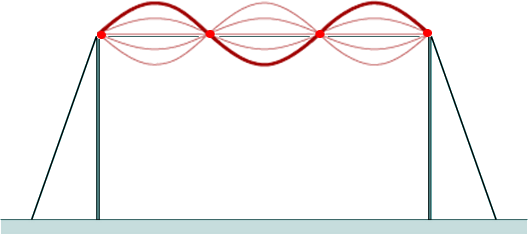Standing Waves or Stationary Waves Q2. The diagram shows a structure that supports a horizontal copper aerial wire W used for transmitting radio signals.
(a) Show that the extension produced in a 12 m length of the aerial wire when the tension is 5.0 × 102 N is less than 4 mm.
ΔL = FL/AE ΔL = 5.0 × 102 x 12/(1.6 × 10–5x 1.2 × 1011) ΔL = 3.1 x 10-3 m ΔL = 3.1 mm < 4.0 mm [2 marks] (b) The cables that support each mast are at an angle of 65° to the horizontal. Calculate the tension in each supporting cable so that there is no resultant horizontal force on either mast. 500 = Tcos 65 T = 1,200 N [1 mark] (c) When wind blows, stationary waves can be formed on the aerial wire. Explain how stationary waves are produced and why only waves of specific frequencies can form on the aerial wire. The wind produces a wave/disturbance that travels along the wire The wave is reflected at each end, so transmitted and reflected waves travel along the wire in opposite directions The incident and reflected waves interfere with each other (or superpose). Only certain frequencies produce a stationary wave as the fixed ends have to be nodes. [4 marks] (d) Calculate the mass of a 1.0 m length of the aerial wire. Density of copper = 8,900 kg m–3 density = mass/volume ρ = m/V m = ρV m = ρAL m = 8,900 x 1.6 × 10–5 x 1.0 m = 0.14(2) kg [1 mark] (e) Calculate the frequency of the wave when the third harmonic is formed on the aerial wire.
For the first harmonic: f = 1/2L x (T/μ)½
f = 1/24 x (5.0 × 102/0.142)½ f = 2.47 Hz Therefore the third harmonic is 3 x 2.47 Hz = 7.4 Hz [2 marks] (f) Sketch, on the diagram below, the standing wave on the wire when the third harmonic is formed.
Diagram showing three approximately equally spaced loops [1 mark] (g) High winds produce large amplitudes of vibration of the aerial wire. Explain why the wire may sag when the high wind stops. Copper may be stretched beyond the elastic limit if the tension produced in it by the wind is excessive. This will deform the wire plastically [2 marks] (Total 13 marks) |
Follow me...
|








